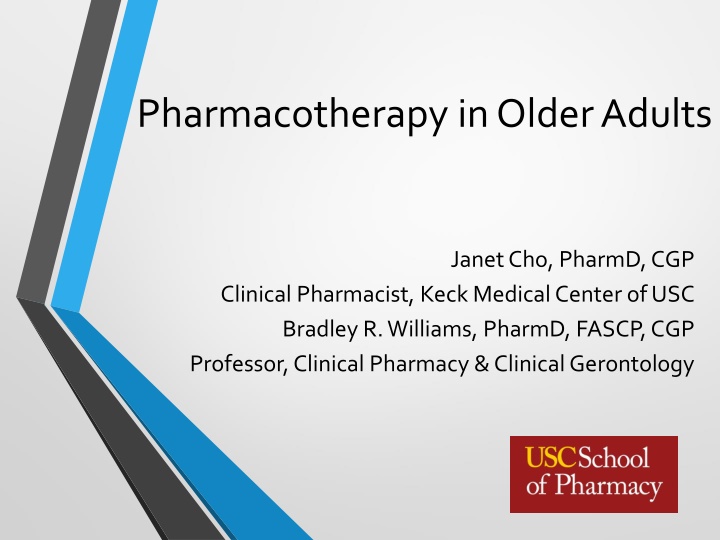
Pharmacotherapy in Older Adults: Addressing Medication Concerns and Age-Associated Issues
Learn about the importance of pharmacotherapy in older adults, the concerns surrounding prescription medication use, and age-related physiological changes affecting drug interactions and reactions. Understand the impact of medication errors on hospital readmissions and the risks associated with inappropriate medication use in aging populations.
Download Presentation

Please find below an Image/Link to download the presentation.
The content on the website is provided AS IS for your information and personal use only. It may not be sold, licensed, or shared on other websites without obtaining consent from the author. If you encounter any issues during the download, it is possible that the publisher has removed the file from their server.
You are allowed to download the files provided on this website for personal or commercial use, subject to the condition that they are used lawfully. All files are the property of their respective owners.
The content on the website is provided AS IS for your information and personal use only. It may not be sold, licensed, or shared on other websites without obtaining consent from the author.
E N D
Presentation Transcript
Pharmacotherapy in Older Adults Janet Cho, PharmD, CGP Clinical Pharmacist, Keck Medical Center of USC Bradley R. Williams, PharmD, FASCP, CGP Professor, Clinical Pharmacy & Clinical Gerontology
Prescription Medication Use Gu Q, et al., NCHS Data Brief No. 42, 2010
Why Are We Concerned? Older adults account for 49.8% of hospital admissions due to adverse drug events1 Rate is greatest for age 85+ years 87% due to hypoglycemics, anticonvulsants, warfarin, digoxin, theophylline, lithium Adults age 50+ account for 51.1% of ED admissions for adverse drug events2 CNS drugs (28.8%), blood modifiers (22.6%), cardiovascular meds (18.1%) are most common 1Budnitz, et al, JAMA, 2006; 2The DAWN Report, 2011
Why Are We Concerned? Medicare hospital readmissions1 30 days (19.6%); 60 days (28.2%) Heart failure, pneumonia, COPD, psychosis are most common discharge diagnoses Preventable medication errors2 Renal and hepatic function Drug interactions Lack of individualized therapy 1 Jencks, et al., NEJM, 2009; 2 Kohn, et al. Institute of Medicine, 2000
Age-associated Issues Physiologic changes affect both pharmacokinetics and pharmacodynamics Reduced physiologic reserve narrows the margin for error Polymedicine increases the risk for adverse reactions and drug interactions Multiple providers and self-care both increase the risk for inappropriate medication use
Physiologic Changes Body composition Increase in body fat (% of total body weight) Women: 33% to 48% Men: 18% to 36% Decrease in body water Reduced serum albumin Increased 1-acid glycoprotein Decreased lean body mass
Physiologic Changes Gastrointestinal tract Increased gastric pH Reduced intestinal blood flow Impaired active & passive transport mechanisms Delayed gastric emptying Slowed GI motility
Physiologic Changes Liver Decreased hepatic mass Reduced hepatic blood flow Kidney Loss of functioning nephrons Reduced renal blood flow Decreased tubular secretion Decreased glomerular filtration
Drug Absorption Primarily a passive process that occurs in the small intestine Rate of absorption may be slowed Delayed, lower peak serum levels Increased bioavailability for some hepatically metabolized drugs due to reduced first-pass effect (e.g., verapamil, labetalol, lidocaine) Transdermal absorption is variable
Drug Distribution Factors leading to altered distribution Increased Total body fat 1-acid glycoprotein Decreased Lean body mass Total body water Serum albumin Cardiac output
Drugs with Decreased Binding NSAIDs Diflunisal* Naproxen* Salicylates* Phenytoin Theophylline Valproate* Warfarin Benzodiazepines Diazepam Lorazepam Temazepam Triazolam Desipramine Meperidine * >50% decrease
Drug Metabolism Factors leading to altered metabolism Reduced liver mass and volume Decreased hepatic blood flow Altered enzyme activity Sex and genetic differences Age-associated declines Drug interactions Nutrition and health status
Aging & CYP Activity Decreased Decreased or Unchanged CYP 2A CYP 2C9 CYP 3A4 Unchanged CYP 1A2 CYP 2C19 CYP 2D6 -Cusack. Am J Geriatr Pharmacother 2004;2:274-302
Other Influences Factor Result Smoking Induction Alcohol Induction Drugs Induction/Inhibition Diet Variable Malnutrition Inhibition, if severe Frailty Inhibition -O Mahoney & Woodhouse. Pharmacol Ther 1994;61:279-287
Drug Renal Excretion Factors leading to altered excretion Reduced kidney mass, number and size of nephrons Decreased renal blood flow Decreased glomerular filtration Reduced tubular secretory mechanisms Effect of disease
CNS Changes Reduced blood flow and oxygenation Increased MAO levels Decreased norepinephrine, dopamine More sensitive to sedating agents Greater sensitivity to anticholinergic agents Increased permeability of the blood-brain barrier
Cardiovascular Changes Decreased response to catecholamines Primarily affects -receptors Increased circulating norepinephrine Reduced cardiac output Increased peripheral resistance Less responsive baroreceptors
Pharmacogenomic Issues No apparent changes across the adult lifespan Possibly some decrease in CYP 3A4 and 2A6 Fast and slow metabolizers N-acetyltransferase activity Slow acetylators (autosomal recessive)
Medication-related Problems Adverse drug reaction Unnecessary medication Duplicate No indication Problem resolved Untreated indication Patient not receiving medication Dose too high Dose too low Improper medication Contraindication Allergy Inappropriate for patient s age or function Drug interaction
Medication Risk Assessment > 5 medications > 12 daily doses Narrow therapeutic index drugs Multiple prescribers Taking medicines for at least 3 problems Uses multiple pharmacies Someone brings medicines to the home Complex regimen At least 4 direction changes in 1 year Any medicine taken for an unknown reason -Levy HB, Ann Pharmacother, 2003
High-risk Patients Multiple diseases Complex regimens Drug-disease interactions Adverse effects Drug-drug interactions Risk for overdosage Multiple drugs Frail Depressed Multiple somatic complaints Non-adherence Unreliable regarding adherence, adverse effects, etc. Demented
Summary Age-associated changes in pharmacokinetics and pharmacodynamics present therapeutic challenges Interpatient variability makes it difficult to predict clinical effects with certainty Disease, nutrition, adherence, other drugs complicate the picture Patients benefit from a risk management approach
